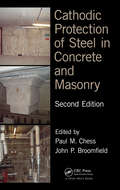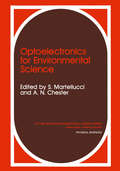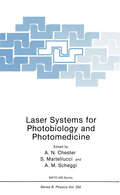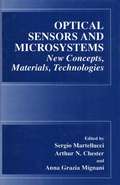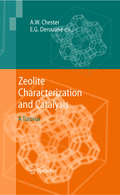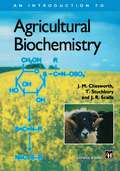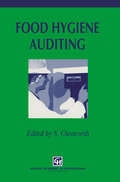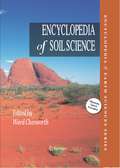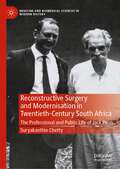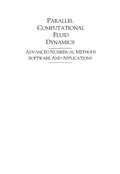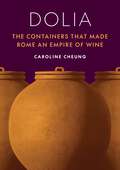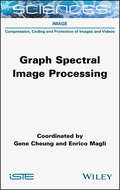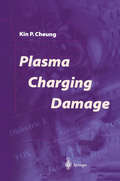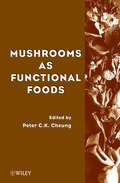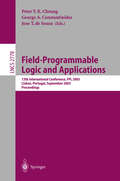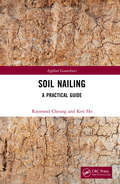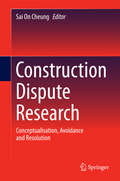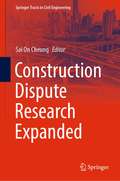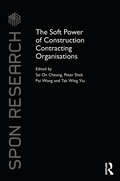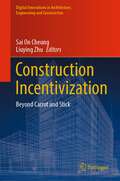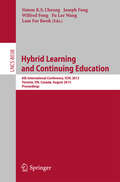- Table View
- List View
Cathodic Protection of Steel in Concrete and Masonry
by Paul M. Chess John P. BroomfieldRevised and updated, this second edition of Cathodic Protection of Steel in Concrete and Masonry covers both reinforced concrete and masonry structures, describes in detail the overall design factors involved in cathodic protection (CP), and also provides a theoretical basis for why it works. It refers to the new European standard EN 12696 for cath
Optoelectronics for Environmental Science: Proceedings of the 14th course of the International School of Quantum Electronics on Optoelectronics for Environmental Science, held September 3–12, 1989, in Erice, Italy (Ettore Majorana International Science Series #54)
by Arthur N. Chester S. MartellucciAs we enter the nineties, there is worldwide awareness that the future of all mankind is inexorably linked by the world we share, and its response to man's activities. Lasers and the optical sciences have brought powerful tools to measure and understand our environment. LIDAR (laser radar) and laser fluorescence allow us to measure atmospheric and oceanic pollutants, as well as industrial emissions, from many kilometers distance. And a variety of sensitive laser-based spectroscopic techniques permit the accurate analysis of heavy metals and other trace elements in the environment. In September 1989, an international group of scientists me.t in Erice, Sicily, for the 14th Course of the International School of Quant~ Electronics. This Course was devoted to "Optoelectronics for Envi~onmental Science", and was ably directed by Prof. V. S. Letokhov of the USSR Institute of Spectroscopy and Prof. A. M. Scheggi of the C.N.R. Electro magnetic Waves Institute, Florence, Italy. This book gives the proceedings of that conference, which covered not only basic tutorial papers but also reports on the latest research results. The first half of this volume describes the techniques used for direct "In-Situ Measurements" of the environment. In "Techniques and Programs", four chapters and one extended abstract give tutorial discussions of the most important remote sensing techniques: LIDAR, laser fluorescence, and optical fiber sensors, plus a description of the Italian program in this area.
Laser Systems for Photobiology and Photomedicine (Nato Science Series B: #252)
by Arthur N. Chester S. Martellucci A. M. Verga ScheggiThis volume contains the Proceedings of a two-week NATO Advanced Study Institute on "Laser Systems for Photobiology and Photomedicine", conducted from May 11 to 20, 1990 in Erice, Italy. This is the 15th annual course of the International School of Quantum Electronics (ISQE), organized under the auspices of the "Ettore Majorana" Center for Scientific Culture. The application of lasers to medicine and surgery has made amazing progress since the last ISQE Course on this subject in 1983. The present Proceedings give a tutorial introduction to today's most important areas, as well as a review of current results by leading researchers. Among the possible approaches to a NATO Advanced Study Institute on Laser Systems for Photobiology and Photomedicine, we chose to emphasize the scientific and technological aspects of advanced laser systems when applied to laboratory and clinical tests. Since it is the policy of the School to stress the advanced scientific and techn·ological achievements in the field of Quantum Electronics, the Course broadly covers performance already achieved and potential applications.
Optical Sensors and Microsystems: New Concepts, Materials, Technologies
by Arthur N. Chester Anna Grazia Mignani S. MartellucciProceedings of the 22nd Course of the International School of Quantum Electronics, held 27 November-2 December 1997, in Erice, Italy. In recent years, fiber optical sensors and optical microsystems have assumed a significant role in sensing and measurement of many kinds. These optical techniques are utilised in a wide range of fields, including biomedicine, environmental sensing, mechanical and industrial measurement, and art preservation. This volume, an up-to-date survey of optical sensors and optical microsystems, aims at combining a tutorial foundation with analysis of current research in this area, and an extensive coverage of both technology and applications.
Zeolite Characterization and Catalysis: A Tutorial
by Arthur W. Chester E. G. DerouaneThe idea for putting together a tutorial on zeolites came originally from my co-editor, Eric Derouane, about 5 years ago. I ?rst met Eric in the mid-1980s when he spent 2 years working for Mobil R&D at our then Corporate lab at Princeton, NJ. He was on the senior technical staff with projects in the synthesis and characterization of new materials. At that time, I managed a group at our Paulsboro lab that was responsible for catalyst characterization in support of our catalyst and process development efforts, and also had a substantial group working on new material synthesis. Hence, our interests overlapped considerably and we met regularly. After Eric moved back to Namur (initially), we maintained contact, and in the 1990s, we met a number of times in Europe on projects of joint interest. It was after I retired from ExxonMobil in 2002 that we began to discuss the tutorial concept seriously. Eric had (semi-)retired and lived on the Algarve, the southern coast of Portugal. In January 2003, my wife and I spent 3 weeks outside of Lagos, and I worked parts of most days with Eric on the proposed content of the book. We decided on a comprehensive approach that ultimately amounted to some 20+ chapters covering all of zeolite chemistry and catalysis and gave it the title Zeolite Chemistry and Catalysis: An integrated Approach and Tutorial.
An Introduction to Agricultural Biochemistry
by J.M. Chesworth T. Stuchbury J.R. ScaifeAgricultural Biochemistry will provide an introduction to the subject of biochemistry from a perspective that will be particularly applicable to agricultural scientists. It will focus on the chemistry of plant and animal metabolism and the biomolecules that are involved in these pathways and then go on to discuss strategies plants and animals adopt for processing of nutrients, the adaptation of these organisms to environmental conditions and the ways in which new genetic engineering techniques can be used to manipulate growth.
Reconstructive Surgery and Modernisation in Twentieth-Century South Africa: The Professional and Public Life of Jack Penn (Medicine and Biomedical Sciences in Modern History)
by Suryakanthie ChettyThis book traces the career of pioneering South African plastic and reconstructive surgeon, Jack Penn, from its beginnings during the Second World War. It explores the establishment of Penn’s private practice, and his work in diverse countries, including Gabon, Japan and Israel, as he sought to rectify the injury caused by conflict. It also addresses his role on the President’s Council, established by Prime Minister P.W. Botha to introduce reform to the system of apartheid.Penn’s career is contextualised by modernisation which was a significant feature of twentieth-century South Africa. It was linked with race from the inception of the state in 1910 with racial segregation and paternalism. Penn’s work during the Second World War was part of a “modernist” bent by the state under Jan Smuts to take the lead in promoting science and technological development – which continued during apartheid. Modernisation was also fluid with state priority shifting between the two poles of development and security as apartheid policies were met with hostility both within the state and beyond its borders. Within the context of decolonisation, increasing black urbanisation required a balancing act on the part of the state to uphold the ideology of racial distinction while simultaneously addressing economic challenges – and this was reflected in the reform initiatives under Botha.Plastic and reconstructive surgery as evident in the work of Jack Penn is intertwined with this narrative of apartheid, modernisation and reform. It demonstrated Western prowess, with medicine and development a perceived bulwark against Communism. It also served as a means for the modernising apartheid state to initiate, maintain or enhance alliances with other states in the facing of mounting isolation and international condemnation.The career of Jack Penn, then, is a lens through which the contradictions, complexities and anxieties of twentieth-century South Africa are exposed.
Parallel Computational Fluid Dynamics 2003: Advanced Numerical Methods, Software and Applications
by Boris Chetverushkin Jacques Periaux N. Satofuka A. EcerThe book is devoted to using of parallel multiprocessor computer systems for numerical simulation of the problems which can be described by the equations of continuum mechanics. Parallel algorithms and software, the problems of meta-computing are discussed in details, some results of high performance simulation of modern gas dynamic problems, combustion phenomena, plasma physics etc are presented.· Parallel Algorithms for Multidisciplinary Studies
Dolia: The Containers That Made Rome an Empire of Wine
by Caroline CheungThe story of the Roman Empire’s enormous wine industry told through the remarkable ceramic storage and shipping containers that made it possibleThe average resident of ancient Rome drank two-hundred-and-fifty liters of wine a year, almost a bottle a day, and the total annual volume of wine consumed in the imperial capital would have overflowed the Pantheon. But Rome was too densely developed and populated to produce its own food, let alone wine. How were the Romans able to get so much wine? The key was the dolium—the ancient world’s largest type of ceramic wine and food storage and shipping container, some of which could hold as much as two-thousand liters. In Dolia, classicist and archaeologist Caroline Cheung tells the story of these vessels—from their emergence and evolution to their major impact on trade and their eventual disappearance.Drawing on new archaeological discoveries and unpublished material, Dolia uncovers the industrial and technological developments, the wide variety of workers and skills, and the investments behind the Roman wine trade. As the trade expanded, potters developed new techniques to build large, standardized dolia for bulk fermentation, storage, and shipment. Dolia not only determined the quantity of wine produced but also influenced its quality, becoming the backbone of the trade. As dolia swept across the Mediterranean and brought wine from the far reaches of the empire to the capital’s doorstep, these vessels also drove economic growth—from rural vineyards and ceramic workshops to the wine shops of Rome.Placing these unique containers at the center of the story, Dolia is a groundbreaking account of the Roman Empire’s Mediterranean-wide wine industry.
Dolia: The Containers That Made Rome an Empire of Wine
by Caroline CheungThe story of the Roman Empire’s enormous wine industry told through the remarkable ceramic storage and shipping containers that made it possibleThe average resident of ancient Rome drank two-hundred-and-fifty liters of wine a year, almost a bottle a day, and the total annual volume of wine consumed in the imperial capital would have overflowed the Pantheon. But Rome was too densely developed and populated to produce its own food, let alone wine. How were the Romans able to get so much wine? The key was the dolium—the ancient world’s largest type of ceramic wine and food storage and shipping container, some of which could hold as much as two-thousand liters. In Dolia, classicist and archaeologist Caroline Cheung tells the story of these vessels—from their emergence and evolution to their major impact on trade and their eventual disappearance.Drawing on new archaeological discoveries and unpublished material, Dolia uncovers the industrial and technological developments, the wide variety of workers and skills, and the investments behind the Roman wine trade. As the trade expanded, potters developed new techniques to build large, standardized dolia for bulk fermentation, storage, and shipment. Dolia not only determined the quantity of wine produced but also influenced its quality, becoming the backbone of the trade. As dolia swept across the Mediterranean and brought wine from the far reaches of the empire to the capital’s doorstep, these vessels also drove economic growth—from rural vineyards and ceramic workshops to the wine shops of Rome.Placing these unique containers at the center of the story, Dolia is a groundbreaking account of the Roman Empire’s Mediterranean-wide wine industry.
Graph Spectral Image Processing
by Gene Cheung Enrico MagliGraph spectral image processing is the study of imaging data from a graph frequency perspective. Modern image sensors capture a wide range of visual data including high spatial resolution/high bit-depth 2D images and videos, hyperspectral images, light field images and 3D point clouds. The field of graph signal processing – extending traditional Fourier analysis tools such as transforms and wavelets to handle data on irregular graph kernels – provides new flexible computational tools to analyze and process these varied types of imaging data. Recent methods combine graph signal processing ideas with deep neural network architectures for enhanced performances, with robustness and smaller memory requirements.The book is divided into two parts. The first is centered on the fundamentals of graph signal processing theories, including graph filtering, graph learning and graph neural networks. The second part details several imaging applications using graph signal processing tools, including image and video compression, 3D image compression, image restoration, point cloud processing, image segmentation and image classification, as well as the use of graph neural networks for image processing.
Graph Spectral Image Processing
by Gene Cheung Enrico MagliGraph spectral image processing is the study of imaging data from a graph frequency perspective. Modern image sensors capture a wide range of visual data including high spatial resolution/high bit-depth 2D images and videos, hyperspectral images, light field images and 3D point clouds. The field of graph signal processing – extending traditional Fourier analysis tools such as transforms and wavelets to handle data on irregular graph kernels – provides new flexible computational tools to analyze and process these varied types of imaging data. Recent methods combine graph signal processing ideas with deep neural network architectures for enhanced performances, with robustness and smaller memory requirements.The book is divided into two parts. The first is centered on the fundamentals of graph signal processing theories, including graph filtering, graph learning and graph neural networks. The second part details several imaging applications using graph signal processing tools, including image and video compression, 3D image compression, image restoration, point cloud processing, image segmentation and image classification, as well as the use of graph neural networks for image processing.
Plasma Charging Damage
by Kin P. CheungIn the 50 years since the invention of transistor, silicon integrated circuit (IC) technology has made astonishing advances. A key factor that makes these advances possible is the ability to have precise control on material properties and physical dimensions. The introduction of plasma processing in pattern transfer and in thin film deposition is a critical enabling advance among other things. In state of the art silicon Ie manufacturing process, plasma is used in more than 20 different critical steps. Plasma is sometimes called the fourth state of matter (other than gas, liquid and solid). It is a mixture of ions (positive and negative), electrons and neutrals in a quasi-neutral gaseous steady state very far from equilibrium, sustained by an energy source that balances the loss of charged particles. It is a very harsh environment for the delicate ICs. Highly energetic particles such as ions, electrons and photons bombard the surface of the wafer continuously. These bombardments can cause all kinds of damage to the silicon devices that make up the integrated circuits.
Mushrooms as Functional Foods
by Peter C. CheungFood scientists will dig into this robust reference on mushrooms Mushrooms as Functional Foods is a compendium of current research on the chemistry and biology, nutritional and medicinal value, and the use of mushrooms in the modern functional foods industry. Topics covered range from the agricultural production of mushrooms to the use of molecular biological techniques like functional genomics; from nutritional values of newly cultivated mushroom species to the multifunctional effects of the unconventional form of mushroom (sclerotium); from the physiological benefits and pharmacological properties of bioactive components in mushrooms to the regulation of their use as functional foods and dietary supplements in different parts of the world. With contributions from leading experts worldwide, this comprehensive reference: * Reviews trends in mushroom use and research, with extensive information on emerging species * Includes coverage of cultivation, physiology, and genetics * Highlights applications in functional foods and medicinal use * Covers worldwide regulations and safety issues of mushrooms in functional foods and dietary supplements * Discusses the classification, identification, and commercial collection of newly cultivated mushroom species * Features a color insert with photographs of different types of mushrooms This is an integrated, single-source reference for undergraduates majoring in food science and nutrition, postgraduates, and professional food scientists and technologists working in the functional food area, and medical and health science professionals interested in alternative medicines and natural food therapies.
Field Programmable Logic and Applications: 13th International Conference, FPL 2003 Lisbon, Portugal, September 1–3, 2003 Proceedings (Lecture Notes in Computer Science #2778)
by Peter Y. K. Cheung Georg A. Constantinides Jose T. De SousaThis book contains the papers presented at the 13th International Workshop on Field Programmable Logic and Applications (FPL) held on September 1–3, 2003. The conference was hosted by the Institute for Systems and Computer Engineering-Research and Development of Lisbon (INESC-ID) and the Depa- ment of Electrical and Computer Engineering of the IST-Technical University of Lisbon, Portugal. The FPL series of conferences was founded in 1991 at Oxford University (UK), and has been held annually since: in Oxford (3 times), Vienna, Prague, Darmstadt,London,Tallinn,Glasgow,Villach,BelfastandMontpellier.Itbrings together academic researchers, industrial experts, users and newcomers in an - formal,welcomingatmospherethatencouragesproductiveexchangeofideasand knowledge between delegates. Exciting advances in ?eld programmable logic show no sign of slowing down. New grounds have been broken in architectures, design techniques, run-time - con?guration, and applications of ?eld programmable devices in several di?erent areas. Many of these innovations are reported in this volume. The size of FPL conferences has grown signi?cantly over the years. FPL in 2002 saw 214 papers submitted, representing an increase of 83% when compared to the year before. The interest and support for FPL in the programmable logic community continued this year with 216 papers submitted. The technical p- gram was assembled from 90 selected regular papers and 56 posters, resulting in this volume of proceedings. The program also included three invited plenary keynote presentations from LSI Logic, Xilinx and Cadence, and three industrial tutorials from Altera, Mentor Graphics and Dafca.
Soil Nailing: A Practical Guide
by Raymond Cheung Ken HoSoil nailing is an in situ soil reinforcement technique that can be used to enhance the stability of slopes, retaining walls, embankments, and excavations. It involves installation of closely spaced, relatively slender unstressed tension-carrying structural elements into the ground to stabilize the soil mass. These elements, which are called soil nails, comprise steel or other engineering materials such as fiber reinforced polymer. Soil nailing did not gain popularity until the 1970s when engineers started to realize that the technique could offer an effective, robust, and economical reinforcing system for a variety of ground conditions. More importantly, the track record has been excellent in that no major collapses have been reported in properly designed and well-constructed soil nailed structures so far. Considerable experience and knowledge of the technique have been gained in the past few decades through systematic technical development work comprising laboratory tests, numerical modeling, physical modeling, site trials and field monitoring covering design, and construction practices. Soil Nailing: A Practical Guide consolidates the experience and advances made in the development and use of the soil nailing technique and encourages a wider adoption of the technique by practitioners. The book is intended for use by postgraduate students, researchers, and practicing civil and geotechnical engineers, who wish to have a more in-depth and fundamental understanding of the theory and practice behind the technique. It presents the basic principles of the technique as well as state-of-the-art knowledge and recommended standard of good practice in respect of design, construction, monitoring, and maintenance of soil nailed structures.
Soil Nailing: A Practical Guide
by Raymond Cheung Ken HoSoil nailing is an in situ soil reinforcement technique that can be used to enhance the stability of slopes, retaining walls, embankments, and excavations. It involves installation of closely spaced, relatively slender unstressed tension-carrying structural elements into the ground to stabilize the soil mass. These elements, which are called soil nails, comprise steel or other engineering materials such as fiber reinforced polymer. Soil nailing did not gain popularity until the 1970s when engineers started to realize that the technique could offer an effective, robust, and economical reinforcing system for a variety of ground conditions. More importantly, the track record has been excellent in that no major collapses have been reported in properly designed and well-constructed soil nailed structures so far. Considerable experience and knowledge of the technique have been gained in the past few decades through systematic technical development work comprising laboratory tests, numerical modeling, physical modeling, site trials and field monitoring covering design, and construction practices. Soil Nailing: A Practical Guide consolidates the experience and advances made in the development and use of the soil nailing technique and encourages a wider adoption of the technique by practitioners. The book is intended for use by postgraduate students, researchers, and practicing civil and geotechnical engineers, who wish to have a more in-depth and fundamental understanding of the theory and practice behind the technique. It presents the basic principles of the technique as well as state-of-the-art knowledge and recommended standard of good practice in respect of design, construction, monitoring, and maintenance of soil nailed structures.
Construction Dispute Research: Conceptualisation, Avoidance and Resolution
by Sai On CheungThere are three specific purposes of Construction Dispute Research. First, this volume aims to summarise studies on construction dispute. Second, apart from the theoretical constructs, where appropriate empirical tests are also included. This approach serves to go beyond the commonly used anecdotal approach for the subject matters. Third, it is the sincere hope of the authors that this book will help shaping research agenda of construction dispute. The studies are mostly framed from a management perspective drawing on methods and concepts in contract law, economics, psychology and management science. The book has twenty chapters that are arranged in four parts covering conceptualisation, avoidance, negotiation and mediation. Part 1 is devoted for dispute conceptualisation. A building is only as strong as its foundation. Thus it is no better start to study construction dispute by conceptualisation. The theme of Part 2 is dispute avoidance. The conventional wisdom of ‘prevention is better than cure’ seems can be applied to all problems. As far as construction dispute is concerned, equitable risk allocation and trust are the two most commonly accepted avoidance strategies. Part 3 focuses on negotiation that is the gateway to resolution as almost all disputes are negotiated first before the service of other mechanisms. Negotiation is sometimes described as an art because settlement may not be obtained solely from legal and rational approaches. Part 3 discusses the behavioral dimensions of construction dispute negotiation. Part 4 deals with Mediation- a form of assisted negotiation. Specially, the skill of the mediators in facilitating settlement, the interrelationships among dispute sources, mediator tactics and mediation outcomes are explored. The studies presented in Construction Dispute Research collectively demonstrate holistic approach in dispute management. Each chapter can be read as a study on its own. Practitioners will find the book a handy reference in dispute management and resolution. Students would find the book useful in explaining in details the causes of dispute, the processes to resolve them. The research design and empirical approaches are particularly useful to students in construction management, architectural, surveying and civil engineering programs.
Construction Dispute Research Expanded (Springer Tracts in Civil Engineering)
by Sai On CheungAs an expansion of the book “Construction Dispute Research” published in 2014, this book presents further contributions and breaks into three new research foci in construction dispute studies. Part A discusses the conceptualization and minimization of biases in construction dispute decisions; Part B examines other impediments against settlement such as inequity, power asymmetry and loss aversion. Part C focuses on realty check of construction dispute negotiation conditions such as market competition, interdependence of contracting parties and dispute avoidance function of construction incentivization. This book showcases new ideas in construction dispute research. It offers research studies that are theory rich and conducted with robust methodologies. The research implications are practical and implementable.
The Soft Power of Construction Contracting Organisations (Spon Research)
by Sai On Cheung Tak Wing Yiu Peter Shek Pui WongAcross the AEC industry, the non-technical skills possessed by organisations are key to their overall performance. In this study, the particular importance of optimising the so-called "soft power" of organisations, is addressed. Things like organisational culture, responsible corporate behaviour, and building trust-based relationships with other stake-holders are seen as facets of a broader organisational capability, and the advantages of this strength are also explored.The internationally conducted research behind this book will provide readers with new insights into effective management, from both inter and intra organisational perspectives. This unique and important book is essential reading for researchers and advanced students of construction management.
The Soft Power of Construction Contracting Organisations (Spon Research)
by Sai On Cheung Tak Wing Yiu Peter Shek Pui WongAcross the AEC industry, the non-technical skills possessed by organisations are key to their overall performance. In this study, the particular importance of optimising the so-called "soft power" of organisations, is addressed. Things like organisational culture, responsible corporate behaviour, and building trust-based relationships with other stake-holders are seen as facets of a broader organisational capability, and the advantages of this strength are also explored.The internationally conducted research behind this book will provide readers with new insights into effective management, from both inter and intra organisational perspectives. This unique and important book is essential reading for researchers and advanced students of construction management.
Construction Incentivization: Beyond Carrot and Stick (Digital Innovations in Architecture, Engineering and Construction)
by Sai On Cheung Liuying ZhuThis book proposes ways to make construction project incentive schemes effective. In this book, construction incentivization is used as a collective term that includes all forms of incentive arrangements aiming to engender extra effort of the contracting parties for the improvement of project performance. This book addresses two questions: i) why so many construction incentive schemes are not delivering the desired outcome? and ii) what will make incentive works under different circumstances? This book contributes to the body of knowledge in construction incentivization by offering conceptualization, showcases and practice suggestions including guidelines for the planning of construction incentive schemes.
Hybrid Learning and Continuing Education: 6th International conference, ICHL 2013, Toronto, ON, Canada, August 12-14, 2013, Proceedings (Lecture Notes in Computer Science #8038)
by Simon K. S. Cheung Joseph Fong Wilfred Fong Fu Lee Wang Lam For KwokThis book constitutes the refereed proceedings of the 6th International Conference on Hybrid Learning, ICHL 2013, held in Toronto, ON, Canada, in August 2013. The 35 papers presented in this volume were carefully reviewed and selected from numerous submissions. The selected articles broadly cover topics on hybrid learning and continuing education, including computer supported collaborative learning, experiences in hybrid learning, pedagogical and psychological issues, e-learning and mobile learning, open education resources and open online courses, and issues in hybrid learning and continuing education.
